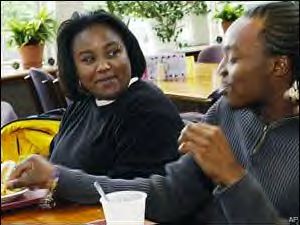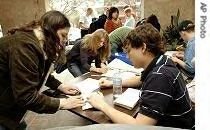 Many states hide behind false data, report says
Many states hide behind false data, report saysThe Education Trust, a Washington think tank, sharply criticizes the way states calculate and report graduation statistics. The analysis, entitled “Getting Honest About Grad Rates: How States Play the Numbers and Students Lose,” also rebukes the U.S. Department of Education for failing to exert leadership by demanding that states get honest about graduation rates.
The Ed Trust analysis reveals disturbing patterns: Some states rely on ludicrous definitions of graduation rates. Others make little effort to accurately account for students who drop out of school. And others still provide no data at all. The final result: Extremely unreliable graduation-rate information that erodes public confidence in schools and their leadership and threatens to undermine the important work of high school reform.
Equally troubling are the appallingly low graduation-rate goals that states set for students under the provisions of the federal No Child Left Behind Act. Under the law, schools must show progress educating all students to state standards in reading and math and must meet state goals for improving graduation rates. Most states have made a mockery of this requirement – setting graduation-rate goals that are lower than the current grad rates they already report to the federal government.
Even worse, despite the fact that the United States now ranks 17th in the developed world in high school completion rates, states have set extraordinarily low goals for improving graduation in the years to come. Most have declared that any progress at all is good enough. And two states, New Mexico and South Carolina, have decided that as long as graduation rates in their high schools don’t actually decline, schools have met the improvement goals of the federal law.
The Ed Trust report comes as the national discussion intensifies on how to boost stagnant achievement in high schools, make U.S. schools more competitive with those in other industrialized nations, and ensure that all students graduate from high school ready for college and work.
“We've got to end this rampant dishonesty about graduation rates,” said Kati Haycock, director of the Education Trust. “If we are going to prepare students for the challenges of college, work, and life, we need to transform our high schools.
“But if we are to persuade policymakers, educators, and the public to take on the vital and necessary work of high school reform, states must start telling the truth – telling the truth about how many students aren't graduating from high school,” she said. “And it would sure help if the U.S. Department of Education stopped sitting on the sidelines and worked to put an end to these shameful practices.”
The report examines the 2002-03 graduation-rate data states provided to the U.S. Department of Education in January 2005. Many states report implausible graduation rates – numbers that are generally far higher than other independent measures of statewide grad rates and hide the true extent of the nation’s dropout problem.
New Mexico – which claimed to have a graduation rate of almost 90 percent, one of the nation’s highest – does not report the percentage of high school freshmen who graduate, but instead reports only the percentage of high school seniors who go on to graduate. This ignores entirely students who dropped out in the 9th, 10th, and 11th grades.
North Carolina, which reports a 97 percent grad rate, uses an even more irrational definition. State officials simply report the percentage of graduates who received their diplomas in four years or less. In other words, students who drop out of high school are excluded from North Carolina’s calculations altogether. Theoretically, if only 50 percent of students who entered high school in North Carolina eventually obtained a diploma, but every one of them did so in four years or less, the state would claim a “graduation rate” of 100 percent.
“It is astonishing that states are trying to pass off these numbers as legitimate,” said Daria Hall, the report’s author and a policy analyst at the Education Trust. “Graduation rates are a fundamental measure of whether high schools are doing a good job. But rather than confront our very real dropout problem, many states have chosen to bury it beneath false data.”
To their credit, some states are working to improve their data systems in a way that will allow them to track individual students and arrive at more accurate graduation-rate numbers. But many are using the fact that they are building data systems to justify reporting inaccurate graduate rates in the meantime.
The Education Trust report calls on states to start using other, more reasonable estimates of graduation rates in the interim. Some states have done so. One is the state of Washington, which in an earlier submission to the federal government reported a questionable graduation rate of 79 percent for the 2001-02 school year. But the state realized that it had counted only students who dropped out in the 12th grade. It has since adopted a calculation that accounts for dropouts in each grade and has arrived at a much lower, but more honest, graduation rate of 66 percent.
Other key findings:
- Three states – Alabama, Louisiana, Massachusetts—and the District of Columbia did not report any graduation rates.
- Seven other states -- Arkansas, Idaho, Kentucky, Michigan, Mississippi, Oklahoma, Vermont -- did not disaggregate their data, effectively hiding the disparity in graduation rates between white and minority students.
In total, 29 states did not provide data for students with disabilities, and 33 did not provide data for students with limited English proficiency. In addition, 33 states did not provide graduation rates for low-income students.
For more than 20 years, educators have said they need better data systems to report more accurate graduation rates. However, according to Ed Trust, they do need better
education data systems to produce data that track every student. As the Ed Trust report demonstrates, schools can start reporting more honest estimates to the public right now. The means to do that are in the hands of every state.
CLICK HERE FOR COPY OF THE REPORT(This is a PDF document. You will need Adobe Acrobat Reader to open it. If Adobe Acrobat Reader is not already installed on your computer, visit Adobe.com for a free download.)
###
The Education Trust works for the high academic achievement of all students at all levels, pre-kindergarten through college, and forever closing the achievement gaps that separate low-income students and students of color from other youth.Tags:
Graduation,
Graduation Rates,
Dropouts,
Student Achievement,
Achievement Gap,
Urban Education,
K-12,
Education,
Education by Sistrunk
 Schools redefine role of subs
Schools redefine role of subs








